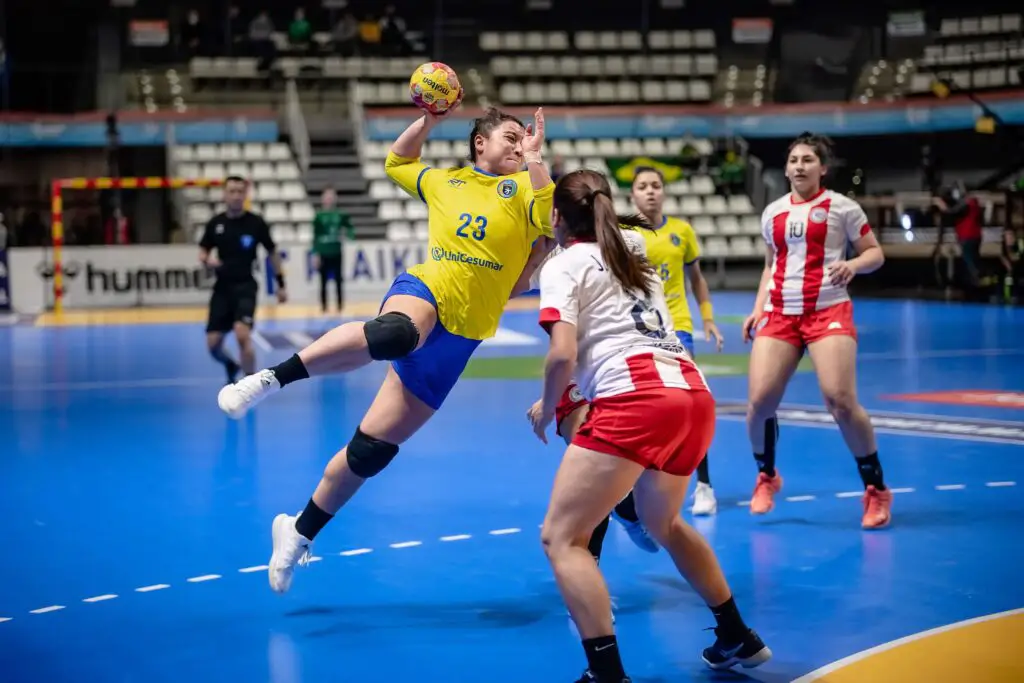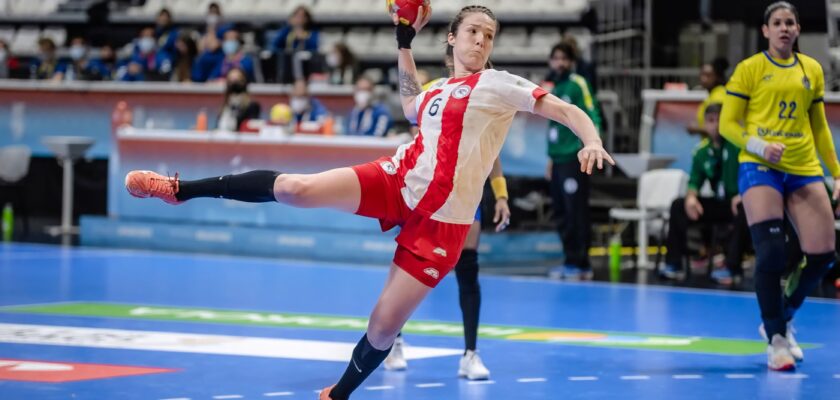Handball has its roots in Europe, being officially created in the late 19th and early 20th centuries. The modern version of the sport was developed in Germany and Denmark. Ready to find out more about the sport and meet the best female handball pivots in Brazil today?
Read on to find out about the best female handball pivots in Brazil today.
🤑 Bet at Bet7k and WIN up to R$7,000 in bonuses on your first deposit. 🚨

In 1906, Danish teacher Holger Nielsen created a version of the sport called “handbold”.
At the same time, the German Karl Schelenz perfected the sport, making it more dynamic and similar to what we know today.
The first handball world championship was held in 1938 in Germany, with only men’s teams. Women’s competitions began to be organized in 1949.
Handball was included in the Olympic Games program for the first time in 1936, but made a definitive comeback in Munich in 1972 for the men and in Montreal in 1976 for the women.
Read on to find out about the best female handball pivots in Brazil today.
The best female handball pivots in Brazil today: Handball rules
Handball is played on a court 40 meters long by 20 meters wide.
Each team consists of seven players (a goalkeeper and six line players). The match is divided into two halves of 30 minutes each, with a 10-minute break in between.
Read on to find out about the best female handball pivots in Brazil today.
Basic rules
- Ball possession: a player can hold the ball for up to three seconds and take up to three steps without bouncing the ball.
- Goals: the aim is to score goals in the opponent’s goal. Each goal is worth one point.
- Goalkeeper’s area: Only the goalkeeper can be inside the 6-meter area surrounding the goal.
- Fouls: excessive physical contact and illegal obstructions result in fouls. Depending on the severity, the player can be penalized with a warning, temporary exclusion (two minutes off), or disqualification.
Read on to find out about the best female handball pivots in Brazil today.
Modalities
There are different types of handball, including:
- Court Handball: the most traditional and popular version, played on indoor courts.
- Beach Handball: played on the sand, with teams of four players and rules adapted to the environment.
- Mini-Handball: adapted for children, with smaller courts and simplified rules to make learning easier.
Read on to find out about the best female handball pivots in Brazil today.
Curiosities about Handball
Popularity
Handball is extremely popular in Europe, especially in countries like France, Denmark, Germany and Norway.
In Brazil
handball is one of the most practiced sports in Brazilian schools, although success in international competitions has historically been lower compared to European countries.
Read on to find out about the best female handball pivots in Brazil today.
Best female handball pivots in Brazil today: characteristics of the position
In handball, the pivot is one of the most strategic and essential positions in the game, playing a crucial role in both attack and defense.
The pivot is the player who positions himself closest to the 6-meter line, the area delimited around the opponent’s goal, where he tries to create spaces, open up paths for shots and score goals.
Pivot functions
- Creating spaces: one of the pivot’s main responsibilities is to open up spaces in the opposing defense. By positioning himself between defenders, the pivot attracts the attention of opponents, creating gaps that can be exploited by his teammates. This is done through constant movement and blocking.
- Receiving passes: the pivot must always be on the lookout to receive passes from his teammates, often in high-pressure situations, with defenders trying to intercept the ball. The ability to control and finish these passes, even in difficult positions, is fundamental to the team’s success.
- Finishing: as well as creating space, the pivot is also one of the team’s main finishers. His proximity to goal puts him in a privileged position to shoot and score, often facing direct confrontations with the opposing goalkeeper.
- Defense: in the defensive phase, the pivot has the job of protecting the central area of the defense, trying to prevent opponents from entering the 6-meter area. He also helps to mark physically stronger players, due to his own strength and endurance.
Read on to find out about the best female handball pivots in Brazil today.
Physical and technical characteristics
- Strength and resilience: due to the constant pressure from defenders and intense physical contact, the pivot needs to be a strong and resilient player. The ability to withstand impacts and maintain balance is essential.
- Agility: despite their strength, pivots also need agility to move quickly in short spaces, feint and position themselves effectively.
- Ball skills: a good pivot must have excellent ball control and the ability to take accurate shots in high-pressure situations, often with defenders grabbing or blocking his movements.
Read on to find out about the best female handball pivots in Brazil today.
Tactical importance
The pivot is a key part of any handball team’s tactical scheme. Their performance can unbalance a match, both in creating offensive plays and in containing opposing attacks.
A pivot’s ability to excel at both ends of the court makes his role one of the most versatile and important in the game.
The pivot position therefore requires a unique set of skills that combine strength, agility, tactical intelligence and precision.
Successful pivots are often the central pillar of their teams, contributing significantly to collective success.
Read on to find out about the best female handball pivots in Brazil today.
Who are the best female handball pivots in Brazil today?
Fabiana “Dara” Diniz
- History: Born in Guaratinguetá, São Paulo, Dara began her career in sport as a teenager.
- Titles: she won the World Cup with the Brazilian national team in 2013 and is a multiple champion in European leagues, especially in France and Hungary.
- Fun facts: Dara is known for her physical strength and ability to open up spaces in the opposition’s defense, and was one of the leaders of the Brazilian national team for several years.
Aline Santos
- History: Born in São Luís, Maranhão, Aline began her career with Brazilian clubs before moving to Europe.
- Titles: She was also world champion in 2013 and has won national titles in countries such as Romania and Turkey.
- Fun facts: Aline is admired for her refined technique and precision in shooting, as well as being a solid defender.
Tamires Morena Lima
- History: Born in Recife, Tamires made a name for herself in the youth ranks before making a name for herself in the senior national team.
- Titles: won gold at the Pan American Games and several national and international championships.
- Fun facts: Tamires is praised for her agility and ability to play fast, and is a key player in both attack and defense.
Ana Paula Rodrigues
- History: Ana Paula, born in São Luís, Maranhão, is one of the most experienced players in Brazilian handball, with a career that includes spells at several European clubs.
- Titles: she was world champion in 2013 with the Brazilian national team and has also won national titles in several European countries, including Romania and Hungary.
- Fun facts: Ana Paula is known for her versatility on the court, playing both center and forward. She is praised for her leadership skills and ability in high-pressure situations.
Adriana “Duda” Amorim
- History: Born in Blumenau, Santa Catarina, Duda Amorim is widely recognized as one of the best handball players in the world, with several international awards under her belt.
- Titles: Duda was named IHF World Player of the Year in 2014 and was world champion in 2013. She also won multiple titles in the Women’s Handball Champions League with Győri Audi ETO KC from Hungary.
- Fun facts: Although Duda is mainly known for her role as a left-back, she has also been used as a pivot on several occasions due to her physical strength and tactical intelligence. She is a global reference in sport and an inspiration to many young athletes.
These players represent the high level of women’s handball in Brazil, bringing experience and talent that continue to elevate the Brazilian national team’s performance in international competitions.
Did you enjoy reading about the best women’s handball forwards in Brazil today? Read also:





